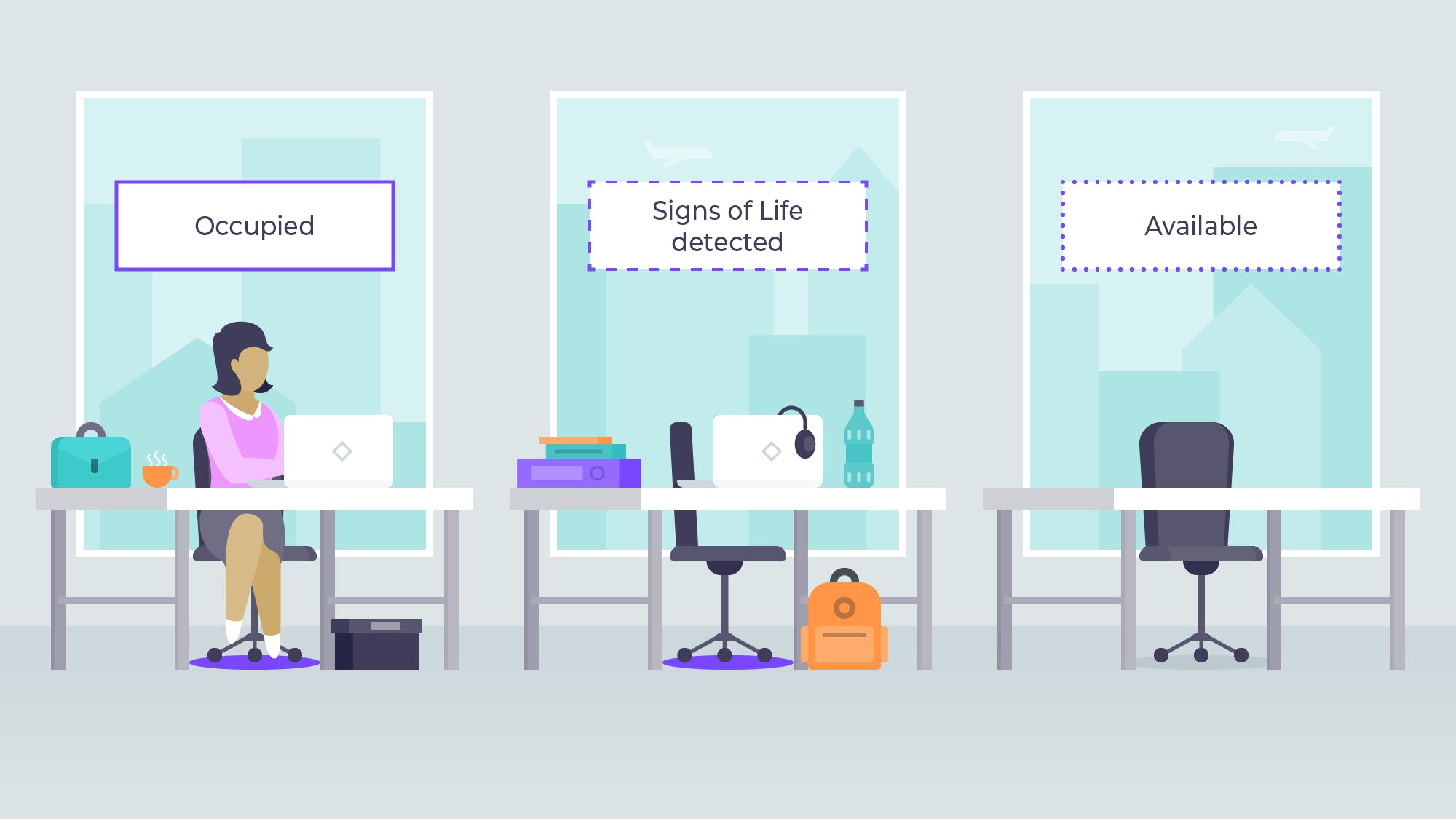10 Data-Powered Strategies to Transform Your Office into a Competitive Advantage

VergeSense is the industry leader in providing enterprises with a true understanding of their occupancy and how their offices are actually being used.
According to a recent Microsoft survey, 66% of leaders say their company is considering redesigning office space to optimize for a hybrid workforce. The question CRE leaders are asking themselves is, what role will the office play moving forward? And what can the office provide that employees can’t receive at home? The same Microsoft survey states, 67% of employees want more in-person collaboration post-pandemic.
In preparation for a post-pandemic world, it’s essential for enterprises to transform the workplace by optimizing and equipping it with the right tools for collaboration, teamwork, and professional development. Now is the time to start making informed decisions to transform your CRE into a competitive advantage. Take a look below at 10 data-powered strategies to maximize productivity, lower operational costs, and provide the ultimate employee experience within your workspaces.
1. Create a seamless workplace experience with real-time occupancy data
The workforce of the future is highly mobile and distributed. Business leaders need to make the employee experience in the office seamless and intuitive. When it comes to reserving desks, real-time occupancy data enables a frictionless experience. Using a booking strategy, employees have control over which spaces they’re going to work in. They can choose a desk for individual work, or reserve a room to collaborate with both their colleagues in-office and those working remotely. By showing employees the desks and rooms available, they can plan their days in the office without struggling to find somewhere to sit or meet.
At the same time, CRE leaders gain a deeper understanding of how they can measure space demand. This provides CRE leaders the visibility into which spaces are actually being used and the primary purpose for each.
2. Repurpose under-utilized spaces with utilization metrics
We’ve all passed by it before: the big conference room that hasn’t held any meetings for weeks. Wouldn’t this space be better utilized for a different purpose? With real-time occupancy sensors, workplace leaders can iterate workplace design quickly by understanding how space is actually being used by employees day to day.
Consider the following questions:
- How are employees using the workspace?
- What types of spaces are most popular?
- What are our visitor patterns?
- How might these patterns change across different business units?
- Are people coming to the office to use collaborative spaces?
Cyber security leader Rapid7, for example, has 14 offices around the world and is growing fast. Its business leaders need to know exactly what’s working, what’s not working, and iterate to make every inch of square footage valuable to employees. Read more about Rapid7's use of utilization data to balance space efficiency.
Additionally, real-time occupancy data helps business leaders better allocate workspaces to each business group based on the group’s in-office habits. With a strategy for repurposing under-utilized space, the office can become an integral tool to increase productivity and encourage cross-functional collaboration.
3. Optimize your global real estate portfolio with data on asset performance
With a workplace analytics platform, CRE leaders can understand, evaluate, and manage their entire portfolio from a single dashboard. There’s even the option to integrate comprehensive data sources to build a cohesive picture of the workplace. CRE leaders need to closely monitor space utilization when employees return to the office. Gathering the right intelligence to make informed decisions about how to optimize space is critical to understanding and maximizing your real estate portfolio.
See how leading enterprises are pioneering their workplace transformations across their real estate portfolios in our latest guide, The World's Most Inspiring Workplace Transformation Stories.
4. Create optimized workplace environments to unlock productivity
Occupancy data helps employees find the right space at the right time and reduces common workplace frictions to unlock productivity. By displaying occupancy data throughout the office, agile seating becomes easier to manage. In real-time, employees can visualize the office space and know which workstations are currently occupied and which are available.
Genentech, a California biotechnology company, has a 30building campus made up of over 4M square feet. Just 2 years ago, the company installed VergeSense occupancy sensors to find out the best mix of spaces for heads down work, teamwork, collaboration, socializing and well-being. They moved to a neighborhood model and saw 30% more people in the existing footprint. Read more on their story.
5. Remove friction with technology to spot passive occupancy
If a coat was hanging on the back of a chair, is that desk in use? Yes. With VergeSense Signs of Life, our sensors allow you to capture and recognize people in spaces as well as the objects commonly used by people to passively occupy spaces when they are not present - such as backpacks, laptops, and clothing. So even if the occupant is away from the desk at the moment, our workplace analytics platform still shows the workstation as occupied. Employees looking for an available workstation are only shown spaces that are truly available. Meanwhile, real estate leaders have a better understanding of how the workplace is being used.

To see Signs of Life™ in action, schedule a one-on-one demo with us today.
6. Make teamwork more efficient by releasing ghosted meeting spaces
Enterprises have struggled with ghosted meeting spaces for many years. Ghosted meeting spaces are booked workstations that no one shows up to use during the time of the booking. This situation threatens productivity by preventing other employees from working or collaborating in the unused booked space. It’s imperative that workplace leaders minimize these events and reduce friction when it comes to employees booking areas within the office.
Having the proper occupancy sensors connected to the right workplace analytics platform creates a smoother employee experience. For instance, when there is a ghosted conference room, occupancy sensors can send a signal to notify the workplace analytics platform. From here, the room can be immediately released so that the conference room is available for other employees to use.
7. Uncover cost savings and improve employee experience with optimized operations
Due to the pandemic, cleaning materials have become much more expensive. To cut down on costs — but ensure quality standards — enterprises need to be much more prescriptive to cleaning crews. With automated cleaning, enterprises are able to reduce costs by only cleaning spaces that have been used. Sensor data can relay to the janitorial staff which spaces are in need of cleaning and in priority order.
Autodesk, global leader in 3D design, for example, has been using VergeSense to understand how their employees are using different office spaces in real-time so they can manage operations in the background such as cleaning, food supply, meal planning, and supply re-filling more efficiently.
8. Create a human-centric design by identified behaviors, trends and patterns
Creating a human-centric workplace design means making data-driven decisions to figure out the best space mix to suit the needs of employees. Data around which spaces are utilized most, which groups of people are gravitating towards certain spaces, and which areas are underutilized will help workplace leaders make transformative decisions on every floor of the office. Other information coming from employee surveys and regional workplace requirements will also prove valuable when it comes to redesigning office space for returning employees.
Creating a workplace centered around employees' needs for personal growth, health, safety, and productivity can positively drive the office redesign. Leveraging occupancy data from analytics solutions will enable workplace leaders to make these data-driven decisions to more effectively design the workplace for increased employee satisfaction and well-being.
9. Scale your data collection with efficient sensors, both wired and wireless
Without accurate data, it's impossible to project how much real estate you need — especially in today's climate. With the right technology powered by smart equipment, enterprises can count how many people come to the office, analyze the use of every room, desk, and lounge space in real time, and ultimately improve the employee experience.
VergeSense ultra-low power sensors install easily and are designed to last years. These next generation sensors run on a self-healing mesh network that collects data reliably and keeps information secure, vastly reducing the complexity of integrating with corporate IT. No need to wait for your next build out to get the feedback you need to inform workplace strategy and design. Learn more.
10. Gather high-fidelity occupancy data with privacy in mind
Privacy is an essential concern to the future workforce. Companies expect to work with vendors that employ technology and protocols to preserve a worker’s privacy. Likewise, vendors are expected to have infosec rigor that ensures all data collected is not only PII-free but is also not a liability. Thus, enterprises must place data integrity at the center of all their technology, business, and design decisions.
In order to protect and respect the employees’ privacy, it’s imperative that enterprises use occupancy sensors that ensure the following:
- Capture of personally identifiable information (PII) is not technically possible
- Raw data captures are destroyed on device
- Metadata is based on an assigned SensorID number and not tied to any geographically identifiable information
- People are counted, not tracked
Final Thoughts
While companies re-imagine the purpose of the physical office, their decisions should rely heavily on employee-centric data and workplace analytics platforms, like VergeSense. The VergeSense Workplace Analytics Platform uses intelligent sensors to capture data and analyze the use of every room, desk, and lounge space, in real time, to simultaneously improve your employee experience and your real estate portfolio.
Although we live in a time where the future of work is constantly evolving, offices remain a competitive tool to create an inclusive, equitable, healthy, and supportive employee experience to attract and retain the best talents for companies.
_____________________________
Interested to see how data-powered strategies can transform your workplace into a competitive advantage? Request a private consultation with the VergeSense team to see the platform in action.